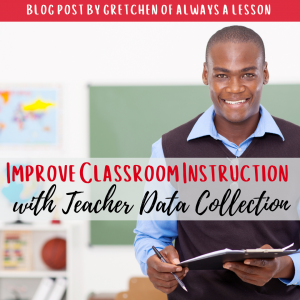Improve Classroom Instruction with Teacher Data Collection
Data collection is a way to gather and track information in order to make educated decisions. It is a great way to figure out what is working well, and what areas to focus on for improvement.
Teachers often collect data on student learning to make adjustments to their instruction to better meet the needs of their students. Instructional coaches can also utilize data collection methods to improve instruction. Through various tracking tools, coaches can hone in on specific areas of instruction and provide support to the teacher to increase effectiveness. It is recommended to choose ONE AREA to hone in on before entering a classroom as it would be difficult to accurately track everything in live time.
Data Collection Process
 The following process allows instructional coaches and leaders to improve classroom instruction through a purposeful ongoing method. It builds in partnership opportunities for the teacher to reflect and the coach to suggest potential next steps for continued growth. The data collection process is inclusive of all teachers and is done with integrity to elicit the most accurate data to inform decision making.
The following process allows instructional coaches and leaders to improve classroom instruction through a purposeful ongoing method. It builds in partnership opportunities for the teacher to reflect and the coach to suggest potential next steps for continued growth. The data collection process is inclusive of all teachers and is done with integrity to elicit the most accurate data to inform decision making.
- Get Organized – Locate the trackers you prefer to use, make individual folders (digital of physical) per teacher to store trackers, and create a schedule so that all teachers are observed sufficiently
- Inform Teachers– Let teachers know that you are trying out a new way to observe their instructional progress by honing in on a single area and documenting the improvement over time (ie. provide a modeled example). Remind them it will be an unannounced visit, to teach as normal, and that the area of focus will not be disclosed until the debrief. This ensures data is a true representation of daily instruction.
- Observe & Track– Pop in classrooms to observe only the area of focus for 15-20 minutes. Visit a handful of classrooms at a time to maximize effort.
- Analyze Trends – Review the data of the focus area for all teachers observed and note group trends (ie. what are they doing well or need to improve on in that area). Review data per teacher comparing the same area of focus over a period of time and note trends (ie. improvements and areas of struggle).
- Engage in Debrief Meetings– Share the data collected with teachers ahead of the meeting to allow them time to analyze their own data and reflect on next steps. This increases their accountability and participation in the debrief. During the debrief, keep it brief: Glows, grows & next steps.
- Repeat Area of Focus – You may need to repeat an area of focus during an observation after a predetermined set of time to note progress. Ideal time frames for data points would be initial, monthly, quarterly and end-of-year.
Common Areas of Focus
The following focus areas move the needle of instruction and therefore should be used by a coach to improve teacher proficiency and student achievement. Examples of what to look for are included below.
- Questioning– What rigor level of questions are asked throughout the lessons? How are questions phrased? Are the same students called on?
- Student Engagement– Are students engaging with the content, each other and the teacher? How often and for how long? What tools or activities are used to drive engagement? Did engagement occur in whole group, small group or in pairs?
- Teacher/Student Actions – Did the teacher plan for specific actions throughout the lesson? Are they purposeful? Are students adhering to expectations? Are procedures clear?
- Addressing Misbehaviors– Are appropriate consequences implemented when needed? Is treatment for and reasonable for all students? Did the teacher follow through to get the student back on track? What is the relationship with students before, during and after misbehaviors occur? Was the teacher able to get the student back on track for learning?
- Content Alignment– Is the standard, objective, assessment and activities aligned? How closely do they match? Is there a common thread found throughout the lesson? Is student understanding of content deepening throughout the lesson and through supports offered?
- Feedback– Who is providing feedback (teacher or student)? To what degree is feedback being implemented? How often is feedback occurring? Is feedback personalized to the learner? What method is used most often to deliver feedback? Is feedback well received?
- Pacing – Is the lesson appropriately paced so that the teacher can complete the lesson in entirety? Are there areas where the pace was too slow or too fast? What indicators did the teacher use to adjust pacing in the moment?
Resources for Data Collection
The following resource will allow you to create and personalize data trackers to best suit the needs of your teachers while also giving them an opportunity to reflect on the data before engaging in a debrief meeting:
If you are need of resources to help you become an even stronger coach, browse these printable and digital options. Check out my instructional coaching must-haves too! Classroom resources are also available here. Also, catch up on other helpful blog posts here.
GO BE GREAT!

What type of teacher data do you collect?

 Get Edu-Tips, Freebies and grab your FREE Study Guide for Gretchen’s New Book!
Get Edu-Tips, Freebies and grab your FREE Study Guide for Gretchen’s New Book!
Your writing has a way of making complex topics seem approachable. Thank you for demystifying this subject for me.
Your blog post was exactly what I needed to hear today. Thank you for the gentle reminder to practice self-care.